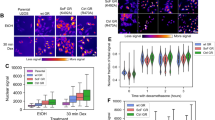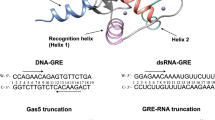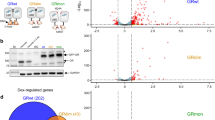Abstract
Transcriptional activation of gene expression by glucocorticoid hormones is mediated by the interaction of hormone–receptor complexes with specific DNA sequences called glucocorticoid responsive elements (GREs) (refs 1–3, see ref. 4 for review). Deletion of this sequence abolishes glucocorticoid induction of transcription4–8. According to a current model, activation of the cytoplasmic receptor protein by hormone binding leads to its increased affinity for and translocation to the nucleus4. However, recent reports that the oestradiol and progesterone receptors are localized in the nucleus in the absence of steroid9–11 led us to examine whether the free receptor interacts in vivo with its DNA binding site in the absence of hormone binding. We used the genomic footprinting technique12–15 to show that changes in in vivo protein–DNA interactions within the GREs of the tyrosine aminotransferase gene (TAT) can be detected only after hormone treatment in hepatoma cells. Such changes are not detected in fibroblast cells, in which the TAT gene is not expressed. Many of the changes in dimethylsulphate reactivity observed in the living cell are also found in vitro using cloned DNA and a partially purified glucocorticoid receptor.
This is a preview of subscription content, access via your institution
Access options
Subscribe to this journal
Receive 51 print issues and online access
$199.00 per year
only $3.90 per issue
Buy this article
- Purchase on Springer Link
- Instant access to full article PDF
Prices may be subject to local taxes which are calculated during checkout
Similar content being viewed by others
References
Payvar, F. P. et al. Cell 35, 381–392 (1983).
Scheidereit, C., Geisse, S., Westphal, H. M. & Beato, M. Nature 304, 749–752 (1983).
Van der Ahe, D. et al. Nature 313, 706–709 (1985).
Yamamoto, K. R. A. Rev. Genet. 19, 209–252 (1985).
Hynes, N. et al. Proc. natn. Acad. Sci. U.S.A. 80, 3637–3641 (1983).
Renkawitz, R., Schütz, G., von der Ahe, D. & Beato, M. Cell 37, 503–510 (1984).
Karin, M. et al. Nature 308, 513–519 (1984).
Miksicek, R. et al. Cell 46, 283–290 (1986).
King, W. J. & Greene, G. L. Nature 307, 745–747 (1984).
Welshons, W. K., Liebermann, M. E. & Gorski, J. Nature 307, 747–749 (1984).
Perrot-Applanat, M., Logeat, F., Groyer-Picard, M. T. & Milgrom, E. Endocrinology 116, 1473–1484 (1985).
Church, G. M. & Gilbert, W. Proc. natn. Acad. Sci. U.S.A. 81, 1991–1995 (1984).
Church, G. M., Ephrussi, A., Gilbert, W. & Tonegawa, S. Nature 313, 798–801 (1985).
Nick, H. & Gilbert, W. Nature 313, 795–797 (1985).
Ephrussi, A., Church, G. M., Tonegawa, S. & Gilbert, W. Science 227, 134–140 (1985).
Becker, P. B., Renkawitz, R. & Schütz, G. EMBO J. 3, 2015–2020 (1984).
Jantzen, M. et al. (in preparation).
Zaret, K. S. & Yamamoto, K. R. Cell 38, 29–38 (1984).
Maxam, A. M. & Gilbert, W. Meth. Enzym. 65, 499 (1978).
Ogata, R. T. & Gilbert, W. Proc. natn. Acad. Sci. U.S.A. 75, 5851–5854 (1978).
Scheidereit, C. & Beato, M. Proc. natn. Acad. Sci. U.S.A. 81, 3029–3033 (1984).
Öfverstedt, L. G. et al. Biochim. biophys. Acta 782, 120–126 (1984).
Gininger, E., Varnum, S. M. & Ptashne, M. Cell 40, 767–774 (1985).
Kruskal, W. H. Ann. math. Statist. 23, 525–540 (1952).
Singh, V. B. & Moudgil, V. K. J. biol. Chem. 260, 3684–3690 (1985).
Author information
Authors and Affiliations
Rights and permissions
About this article
Cite this article
Becker, P., Gloss, B., Schmid, W. et al. In vivo protein–DNA interactions in a glucocorticoid response element require the presence of the hormone. Nature 324, 686–688 (1986). https://doi.org/10.1038/324686a0
Received:
Accepted:
Issue Date:
DOI: https://doi.org/10.1038/324686a0
This article is cited by
-
Nucleosome density shapes kilobase-scale regulation by a mammalian chromatin remodeler
Nature Structural & Molecular Biology (2023)
-
Janus effect of glucocorticoids on differentiation of muscle fibro/adipogenic progenitors
Scientific Reports (2020)
-
Soluble Production of Human Recombinant VEGF-A121 by Using SUMO Fusion Technology in Escherichia coli
Molecular Biotechnology (2018)
-
Interplay between circadian clock and viral infection
Journal of Molecular Medicine (2017)
-
Expression and rapid purification of recombinant biologically active ovine growth hormone with DsbA targeting to Escherichia coli inner membrane
Applied Microbiology and Biotechnology (2015)
Comments
By submitting a comment you agree to abide by our Terms and Community Guidelines. If you find something abusive or that does not comply with our terms or guidelines please flag it as inappropriate.



